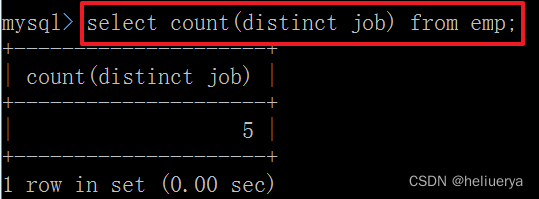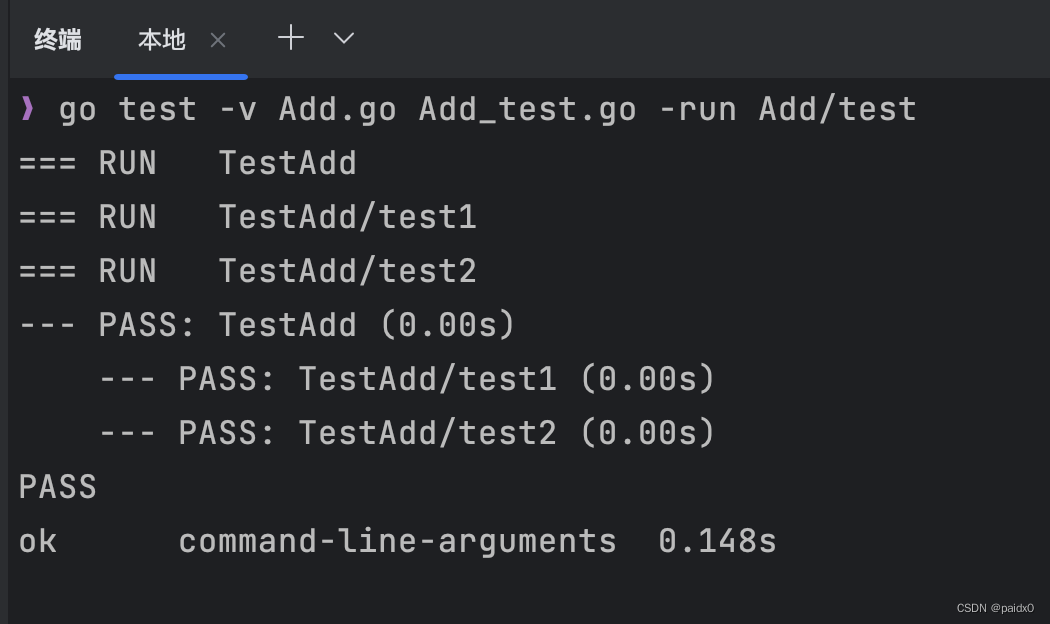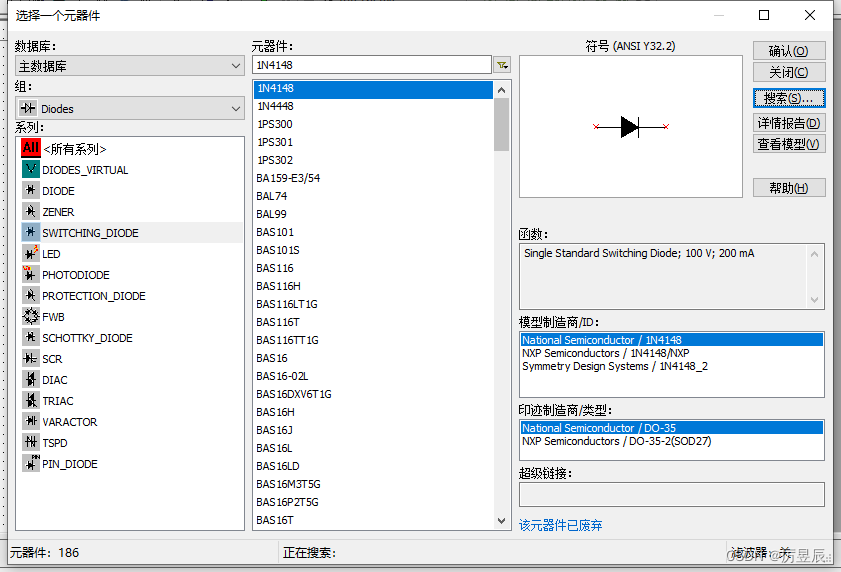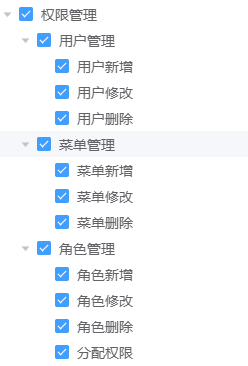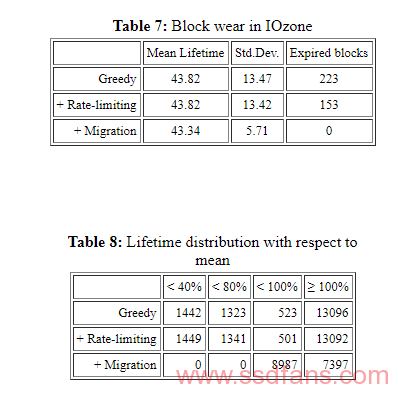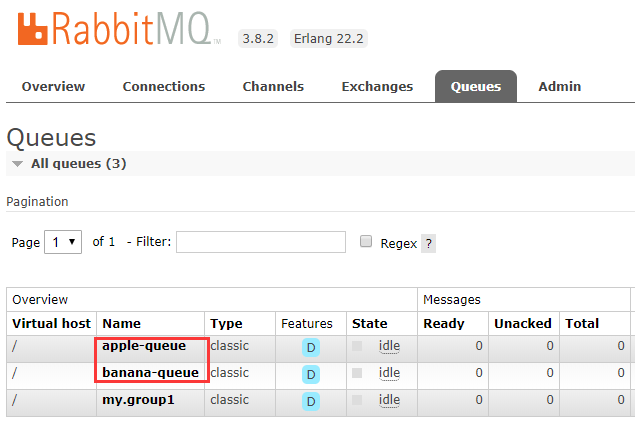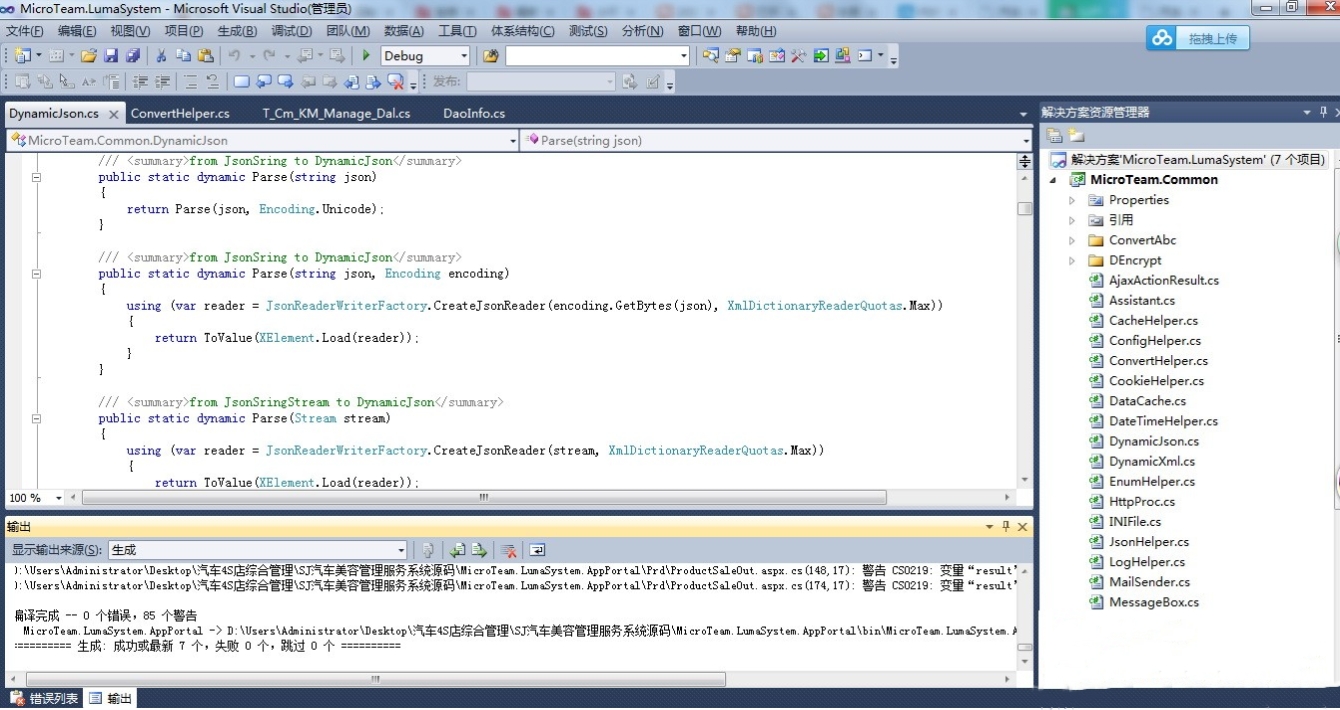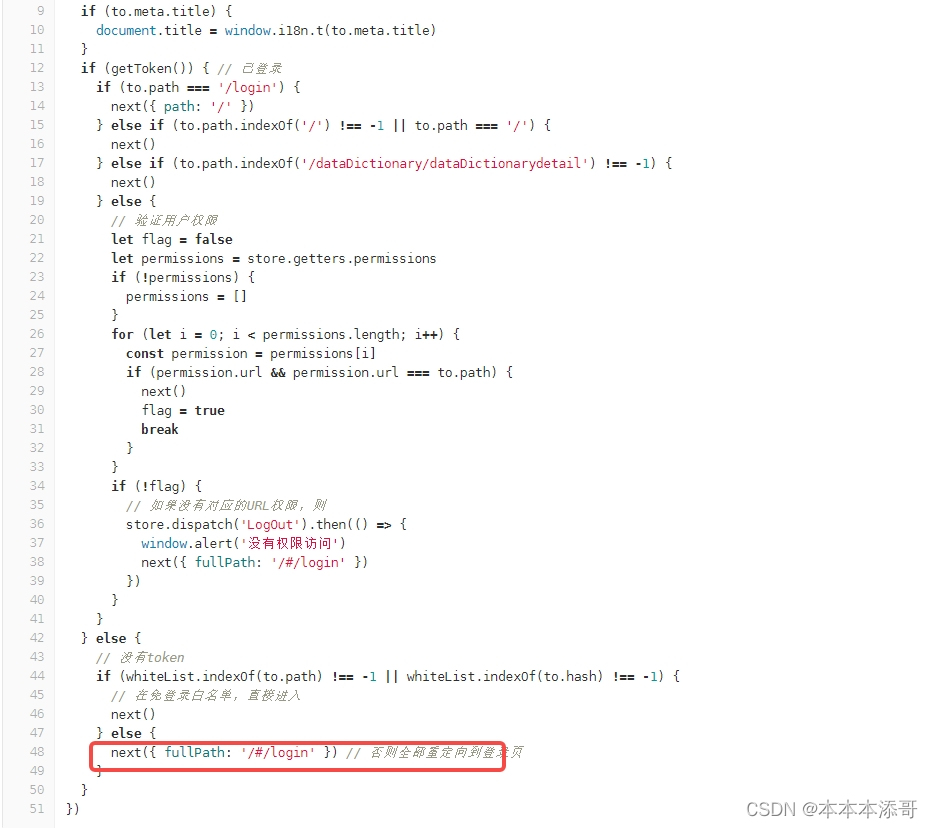1 路由的简介-router
1、路由就是一组key-value的对应关系。
2、多个路由,需要经过路由器的管理。
SPA (single page web application)应用 - 单页面web应用
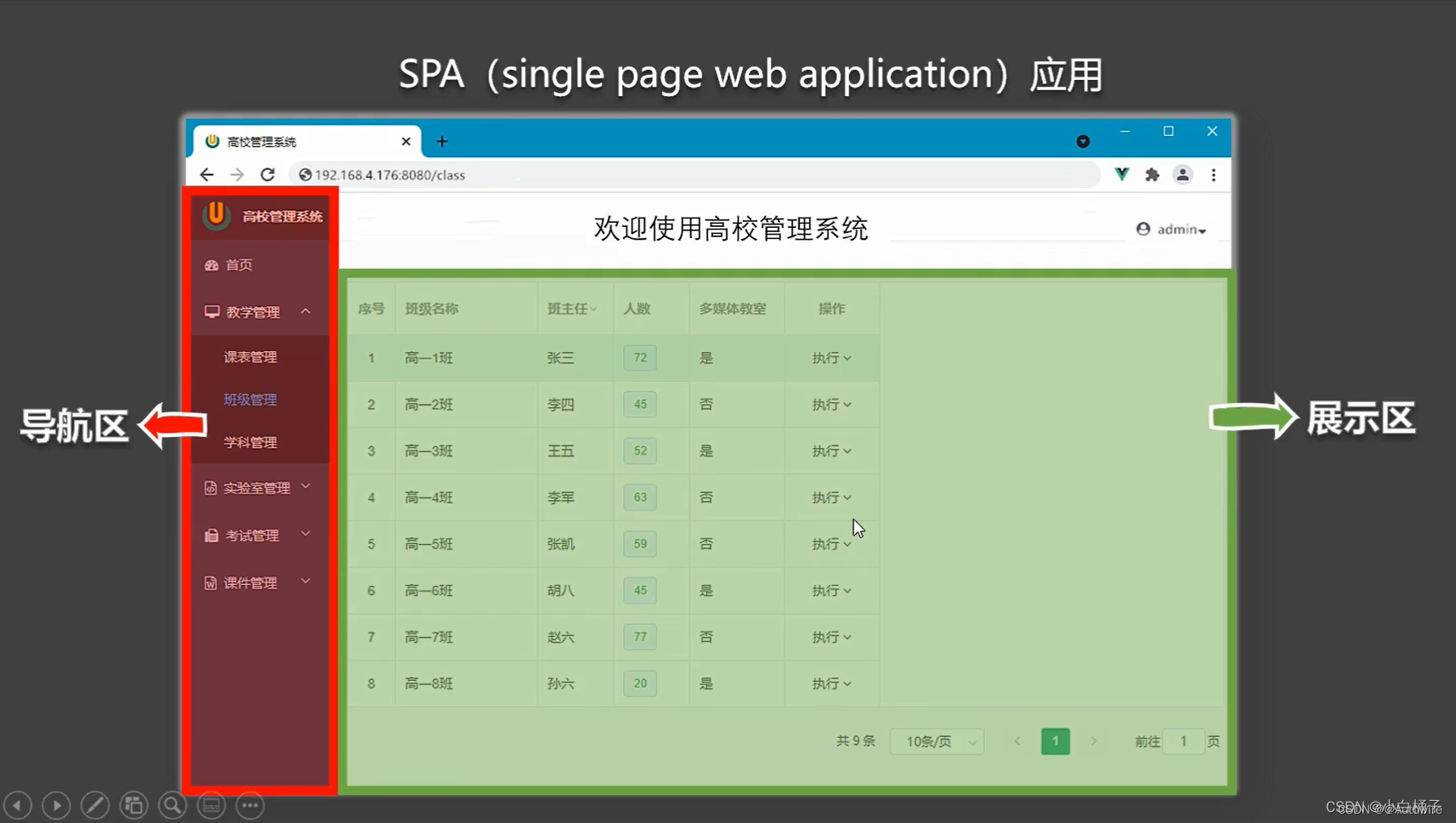
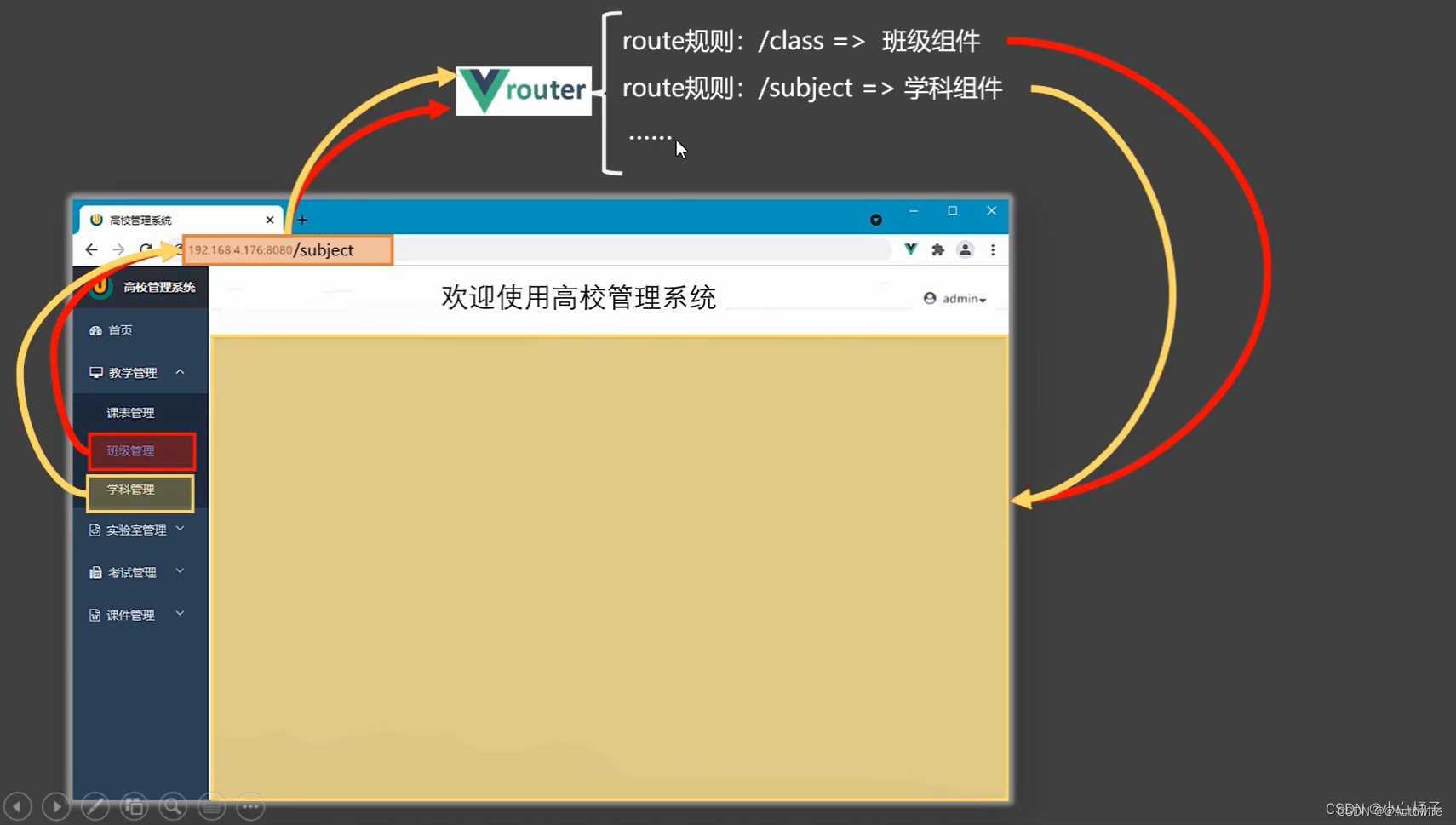
{
"key":"/class",
"value":"班级组件"
}
1.vue-router的理解:
vue的一个插件库,专门用来实现SPA应用。
2.对SPA应用的理解:
1)单页Web应用(single page web application, SPA)。
2)整个应用只有一个完整的页面。
3)点击页面中的导航链接不会刷新页面,只会做页面的局部更新。
4)数据需要通过 ajax 请求获取。
3.路由的理解:
1)什么是路由?
一个路由就是一组映射关系(key - value)
key 为路径, value 可能是 function 或 component
2)路由分类
后端路由:
1)理解:value 是 function, 用于处理客户端提交的请求。
2)工作过程:服务器接收到一个请求时, 根据请求路径找到匹配的函数来处理请求, 返回响应数据。
前端路由:
1)理解:value 是 component,用于展示页面内容。
2)工作过程:当浏览器的路径改变时, 对应的组件就会显示。
2 路由基本使用
路由 理解:一个路由(route)就是一组映射关系(key - value),多个路由需要路由器(router)进行管理。
前端路由:key是路径,value是组件。
1.基本使用:
1)安装vue-router,命令:npm i vue-router
2)应用插件:Vue.use(VueRouter)
3)编写router配置项:
index.js
// 该文件专门用于创建整个应用的路由器
import VueRouter from "vue-router";
// 引入组件
import About from "@/components/About";
import Home from "@/components/Home";
// 创建一个路由器
export default new VueRouter({
routes: [
{
path: '/about',
component: About
},
{
path: '/home',
component: Home
},
]
})
4)实现切换
App.vue
<template>
<div>
<div>
<h2>Vue Router Demo</h2>
</div>
<div>
<!-- 原始html中我们使用a标公实现页面的跳转-->
<!-- <a class="list-group-item active" href="./about.html">About</a>-->
<!-- <a class="list-group-item" href="./home.html">Home</a>-->
<!-- 通过路由的方式-->
<router-link active-class="active" to="/Home"> Home</router-link>
<router-link active-class="active" to="/About"> About</router-link>
</div>
<div>
<!-- router-view - 指定组件的呈现位置-->
<router-view></router-view>
</div>
</div>
</template>
<script>
export default {
name: 'app',
components: {}
}
</script>
5)指定展示位置
<div>
<!-- router-view - 指定组件的呈现位置-->
<router-view></router-view>
</div>
代码:
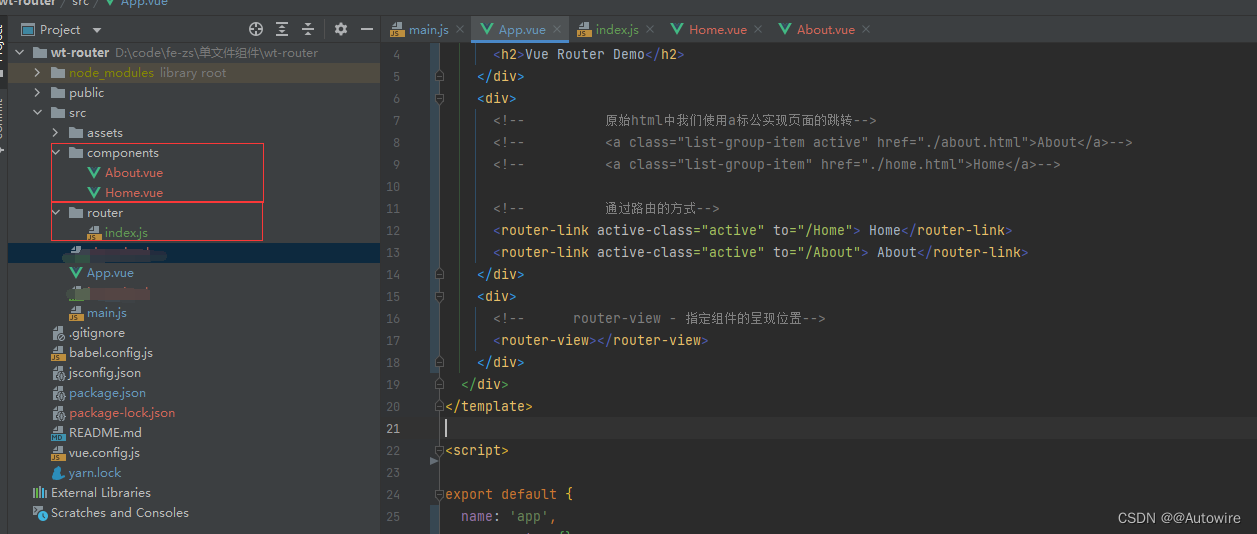
还有两个组件:
About.vue
<template>
<h2>i am about</h2>
</template>
<script>
export default {
name: `About`
}
</script>
<style>
</style>
Home.vue
<template>
<h2>i am home</h2>
</template>
<script>
export default {
name: `Home`
}
</script>
<style>
</style>
main.js
import Vue from 'vue'
import App from './App.vue'
// 引入vue-router
import VueRouter from 'vue-router'
// 引入路由器
import router from "@/router";
//应用插件
Vue.use(VueRouter)
Vue.config.productionTip = false
new Vue({
render: h => h(App),
router: router
}).$mount('#app')


3 几个注意点
(1)路由组件通常存放在pages文件夹,一般组件通常存放在components文件夹。
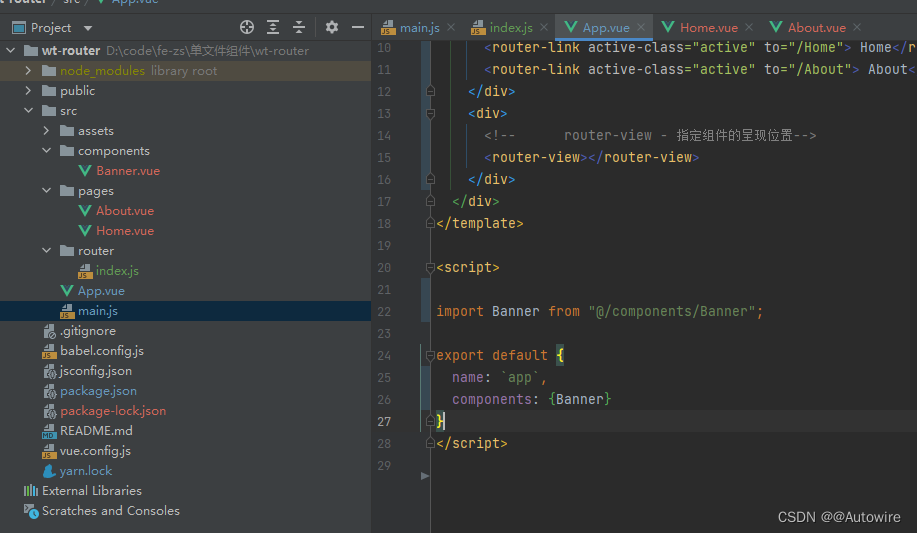
(2)通过切换,“隐藏”了的路由组件,默认是被销毁掉的,需要的时候再去挂载。
(3)每个组件都有自己的$route属性,里面存储着自己的路由信息。
(4)整个应用中只有一个router,可以通过组件的$router属性获取到。
4 嵌套路由
1)配置路由规则,使用children配置项
// 该文件专门用于创建整个应用的路由器
import VueRouter from "vue-router";
// 引入组件
import About from "@/pages/About";
import Home from "@/pages/Home";
import News from "@/pages/News";
import Message from "@/pages/Message";
// 创建一个路由器
export default new VueRouter({
routes: [
{
path: '/about',
component: About,
},
{
path: '/home',
component: Home,
// 二级路由
children: [
{
path: 'news',
component: News
},
{
path: 'message',
component: Message
},
]
},
]
})
2)跳转(要写完整路径)
<template>
<div>
<h2>Home组件内容</h2>
<div>
<ul>
<li>
<router-link to="/home/news">News</router-link>
</li>
<li>
<router-link to="/home/message">Message</router-link>
</li>
</ul>
<router-view></router-view>
</div>
</div>
</template>
<script>
export default {
name: `Home`
}
</script>
<style>
</style>
其他文件:
Message.vue
<template>
<div>
<ul>
<li>
<a href="/message1">message001</a>
</li>
<li>
<a href="/message2">message002</a>
</li>
<li>
<a href="/message3">message003</a>
</li>
</ul>
</div>
</template>
<script>
export default {
name: `Message`
}
</script>
<style>
</style>
News.vue
<template>
<ul>
<li>news001</li>
<li>news002</li>
<li>news003</li>
</ul>
</template>
<script>
export default {
name: `News`
}
</script>
<style>
</style>

5 路由的query参数
路由的query参数
1)作用:跳转的时候传递参数
2)如何使用:
跳转路由并携带query参数,有两种写法:
Message.vue
<template>
<div>
<ul>
<li v-for="item in messageList" :key="item.id">
<!-- 跳转路由并携带query参数,to的字符串写法 -->
<!-- <router-link :to="`/home/message/detail?id=${item.id}&title=${item.title}`">{{ item.title }}</router-link> -->
<!-- 跳转路由并携带query参数,to的对象写法 -->
<router-link :to="{
path: '/home/message/detail',
query: {
id: item.id,
title: item.title
}
}">{{ item.title }}
</router-link>
</li>
</ul>
<hr/>
<router-view></router-view>
</div>
</template>
<script>
export default {
name: `Message`,
data() {
return {
messageList: [
{id: '001', title: '消息001'},
{id: '002', title: '消息002'},
{id: '003', title: '消息003'},
]
}
}
}
</script>
<style>
</style>
用$route.query接收参数:
<li>消息编号:{{$route.query.id}}</li>
<li>消息标题:{{$route.query.title}}</li>
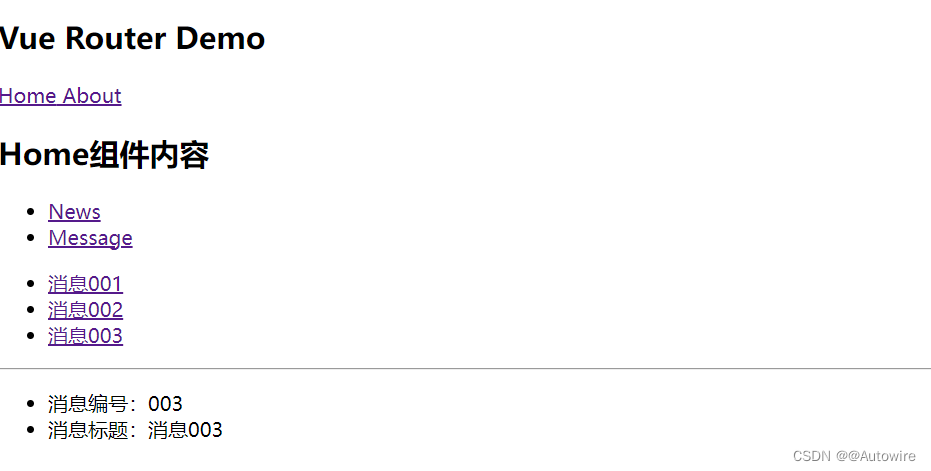
其他文件:
index.js
// 该文件专门用于创建整个应用的路由器
import VueRouter from "vue-router";
// 引入组件
import About from "@/pages/About";
import Home from "@/pages/Home";
import News from "@/pages/News";
import Message from "@/pages/Message";
import Detail from "@/pages/Detail";
// 创建一个路由器
export default new VueRouter({
routes: [
{
path: '/about',
component: About,
},
{
path: '/home',
component: Home,
// 二级路由
children: [
{
path: 'news',
component: News
},
{
path: 'message',
component: Message,
children: [
{
path: 'detail',
component: Detail
}
]
},
]
},
]
})
Detail.vue
<template>
<ul>
<li>消息编号:{{ $route.query.id }}</li>
<li>消息标题:{{ $route.query.title }}</li>
</ul>
</template>
<script>
export default {
name: `Detail`,
mounted() {
}
}
</script>
<style>
</style>
6 命名路由
1)作用:可以简化路由的跳转。
2)如何使用:
给路由命名:
// 该文件专门用于创建整个应用的路由器
import VueRouter from "vue-router";
// 引入组件
import About from "@/pages/About";
import Home from "@/pages/Home";
import News from "@/pages/News";
import Message from "@/pages/Message";
import Detail from "@/pages/Detail";
// 创建一个路由器
export default new VueRouter({
routes: [
{ name: 'guanyu',
path: '/about',
component: About,
},
{
path: '/home',
component: Home,
// 二级路由
children: [
{
path: 'news',
component: News
},
{
path: 'message',
component: Message,
children: [
{ name: 'xiangqing',
path: 'detail',
component: Detail
}
]
},
]
},
]
})
简化跳转:
<template>
<div>
<ul>
<li v-for="item in messageList" :key="item.id">
<!-- 跳转路由并携带query参数,to的字符串写法 -->
<!-- <router-link :to="`/home/message/detail?id=${item.id}&title=${item.title}`">{{ item.title }}</router-link> -->
<!-- 跳转路由并携带query参数,to的对象写法 -->
<router-link :to="{
// path: '/home/message/detail',
name: 'xiangqing',
query: {
id: item.id,
title: item.title
}
}">{{ item.title }}
</router-link>
</li>
</ul>
<hr/>
<router-view></router-view>
</div>
</template>
<script>
export default {
name: `Message`,
data() {
return {
messageList: [
{id: '001', title: '消息001'},
{id: '002', title: '消息002'},
{id: '003', title: '消息003'},
]
}
}
}
</script>
<style>
</style>
7 路由的params参数
1)配置路由,声明接收params参数
// 该文件专门用于创建整个应用的路由器
import VueRouter from "vue-router";
// 引入组件
import About from "@/pages/About";
import Home from "@/pages/Home";
import News from "@/pages/News";
import Message from "@/pages/Message";
import Detail from "@/pages/Detail";
// 创建一个路由器
export default new VueRouter({
routes: [
{ name: 'guanyu',
path: '/about',
component: About,
},
{
path: '/home',
component: Home,
// 二级路由
children: [
{
path: 'news',
component: News
},
{
path: 'message',
component: Message,
children: [
{ name: 'xiangqing',
path: 'detail/:id/:title',
component: Detail
}
]
},
]
},
]
})
2)传递参数
<template>
<ul>
<!-- <li>消息编号:{{ $route.query.id }}</li>
<li>消息标题:{{ $route.query.title }}</li>-->
<li>消息编号:{{ $route.params.id }}</li>
<li>消息标题:{{ $route.params.title }}</li>
</ul>
</template>
<script>
export default {
name: `Detail`,
mounted() {
}
}
</script>
<style>
</style>
特别注意:路由携带params参数时,若使用to的对象写法,则不能使用path配置项,必须使用name配置!
3)接收参数
<template>
<div>
<ul>
<li v-for="item in messageList" :key="item.id">
<!-- 跳转路由并携带query参数,to的字符串写法 -->
<!-- <router-link :to="`/home/message/detail/${item.id}/${item.title}`">{{ item.title }}</router-link> -->
<!-- 跳转路由并携带query参数,to的对象写法 -->
<!-- <router-link :to="{
// path: '/home/message/detail',
name: 'xiangqing',
query: {
id: item.id,
title: item.title
}
}">{{ item.title }}
</router-link>-->
<router-link :to="{
// params 传值 只能是 name
name: 'xiangqing',
params: {
id: item.id,
title: item.title
}
}">{{ item.title }}
</router-link>
</li>
</ul>
<hr/>
<router-view></router-view>
</div>
</template>
<script>
export default {
name: `Message`,
data() {
return {
messageList: [
{id: '001', title: '消息001'},
{id: '002', title: '消息002'},
{id: '003', title: '消息003'},
]
}
}
}
</script>
<style>
</style>
8 路由的props配置
让路由组件更方便的收到参数
index.js
// 该文件专门用于创建整个应用的路由器
import VueRouter from "vue-router";
// 引入组件
import About from "@/pages/About";
import Home from "@/pages/Home";
import News from "@/pages/News";
import Message from "@/pages/Message";
import Detail from "@/pages/Detail";
// 创建一个路由器
export default new VueRouter({
routes: [
{
name: 'guanyu',
path: '/about',
component: About,
},
{
path: '/home',
component: Home,
// 二级路由
children: [
{
path: 'news',
component: News
},
{
path: 'message',
component: Message,
children: [
{
name: 'xiangqing',
// path: 'detail/:id/:title',
path: 'detail',
component: Detail,
// props的第一种写法,值为对象,该对象中的所有key-value都会以props的形式传给Detail组件 - 死的数据
// props: {
// a: 1,
// b: 'hello'
// }
// props的第二种写法,值为布尔值,若布尔值为真,就会把该路由组件收到的所有params参数,以props的形式传给Detail组件
// props: true
// props的第三种写法,值为函数,该函数返回的对象中每一组key-value都会通过props传给Detail组件
props($route) {
return {
id: $route.query.id,
title: $route.query.title
}
}
}
]
},
]
},
]
})
Detail.vue
<template>
<ul>
<!-- <li>消息编号:{{ $route.query.id }}</li>
<li>消息标题:{{ $route.query.title }}</li>-->
<!-- <li>消息编号:{{ $route.params.id }}</li>
<li>消息标题:{{ $route.params.title }}</li>-->
<!-- <li>消息编号:{{ a }}</li>-->
<!-- <li>消息标题:{{ b }}</li>-->
<!-- <li>消息编号:{{ id }}</li>-->
<!-- <li>消息标题:{{ title }}</li>-->
<li>消息编号:{{ id }}</li>
<li>消息标题:{{ title }}</li>
</ul>
</template>
<script>
export default {
name: `Detail`,
// props: ['a', 'b'],
props: ['id', 'title'],
mounted() {
}
}
</script>
<style>
</style>
Message.vue
<template>
<div>
<ul>
<li v-for="item in messageList" :key="item.id">
<!-- 跳转路由并携带query参数,to的字符串写法 -->
<!-- <router-link :to="`/home/message/detail/${item.id}/${item.title}`">{{ item.title }}</router-link> -->
<!-- 跳转路由并携带query参数,to的对象写法 -->
<!-- <router-link :to="{
// path: '/home/message/detail',
name: 'xiangqing',
query: {
id: item.id,
title: item.title
}
}">{{ item.title }}
</router-link>-->
<router-link :to="{
// params 传值 只能是 name
name: 'xiangqing',
query: {
id: item.id,
title: item.title
}
}">{{ item.title }}
</router-link>
</li>
</ul>
<hr/>
<router-view></router-view>
</div>
</template>
<script>
export default {
name: `Message`,
data() {
return {
messageList: [
{id: '001', title: '消息001'},
{id: '002', title: '消息002'},
{id: '003', title: '消息003'},
]
}
}
}
</script>
<style>
</style>
9 router-link的replace属性
点击页面所经过的url都会保存到栈中 (push模式)
...
...
4 http://localhost:8080/#/home/message/detail?id=001&title=%E6%B6%88%E6%81%AF001
3 http://localhost:8080/#/home/message
2 http://localhost:8080/#/Home
1 http://localhost:8080/#/
1)作用:控制路由跳转时操作浏览器历史记录的模式。
2)浏览器的历史记录有两种写入方式,分别为push和replace,push是追加历史记录,replace是替换当前记录。路由跳转时候默认为push。
3)如何开启replace模式:
<router-link replace active-class="active" :to="{
name: 'guanyu'
}"> About</router-link>

10 编程式路由导航
编程式路由导航
作用:不借助router-link实现路由跳转,让路由跳转更加灵活
<template>
<div>
<ul>
<li v-for="item in messageList" :key="item.id">
<router-link :to="{
name: 'xiangqing',
query: {
id: item.id,
title: item.title
}
}">{{ item.title }}
</router-link>
<button @click="pushShow(item)">push查看</button>
<button>replace查看</button>
</li>
</ul>
<hr/>
<router-view></router-view>
</div>
</template>
<script>
export default {
name: `Message`,
data() {
return {
messageList: [
{id: '001', title: '消息001'},
{id: '002', title: '消息002'},
{id: '003', title: '消息003'},
]
}
},
methods: {
pushShow(item) {
this.$router.push({
name: 'xiangqing',
query: {
id: item.id,
title: item.title
}
})
}
}
}
</script>
<style>
</style>
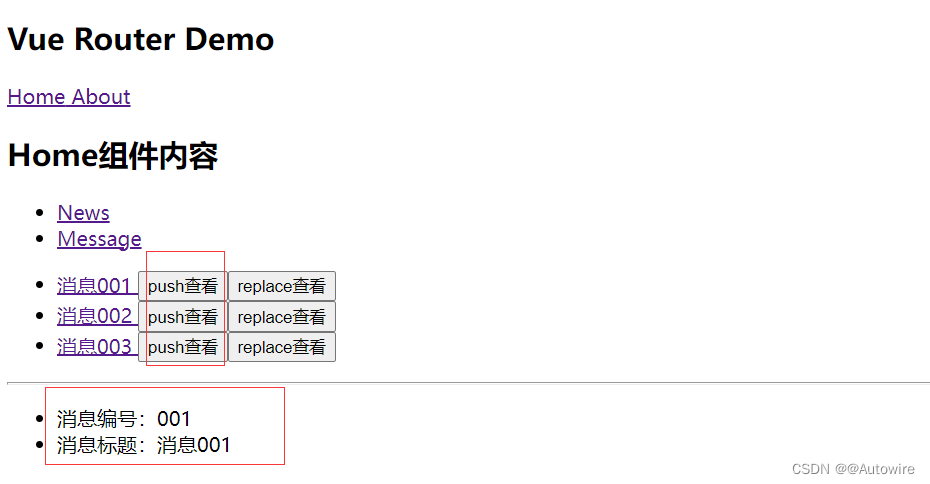
<template>
<div>
<ul>
<li v-for="item in messageList" :key="item.id">
<router-link :to="{
name: 'xiangqing',
query: {
id: item.id,
title: item.title
}
}">{{ item.title }}
</router-link>
<button @click="pushShow(item)">push查看</button>
<button @click="replaceShow(item)">replace查看</button>
</li>
</ul>
<hr/>
<router-view></router-view>
</div>
</template>
<script>
export default {
name: `Message`,
data() {
return {
messageList: [
{id: '001', title: '消息001'},
{id: '002', title: '消息002'},
{id: '003', title: '消息003'},
]
}
},
methods: {
pushShow(item) {
this.$router.push({
name: 'xiangqing',
query: {
id: item.id,
title: item.title
}
})
},
replaceShow(item) {
this.$router.replace({
name: 'xiangqing',
query: {
id: item.id,
title: item.title
}
})
}
}
}
</script>
<style>
</style>
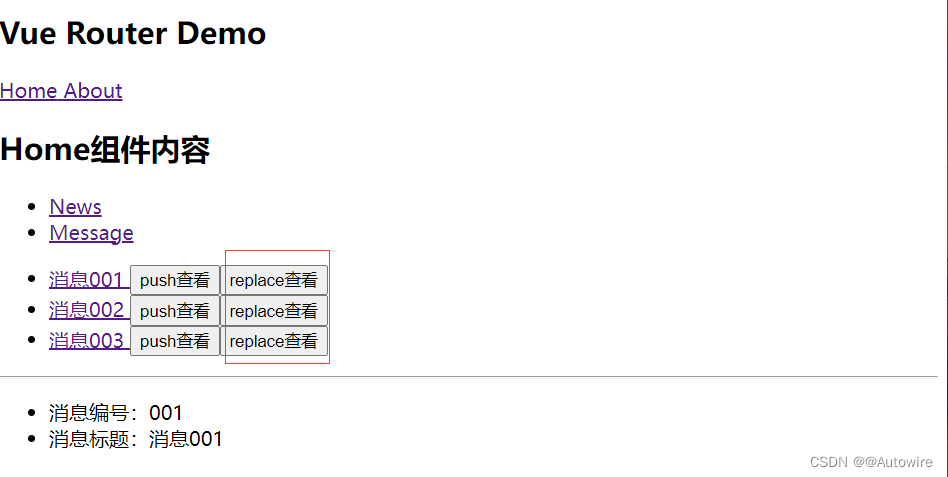
<template>
<div>
<h2>Vue Router Demo</h2>
<button @click="back">后退</button>
<button @click="forward">前进</button>
</div>
</template>
<script>
export default {
name: `Banner`,
methods: {
back() {
this.$router.back()
},
forward() {
this.$router.forward()
},
}
}
</script>
<style>
</style>
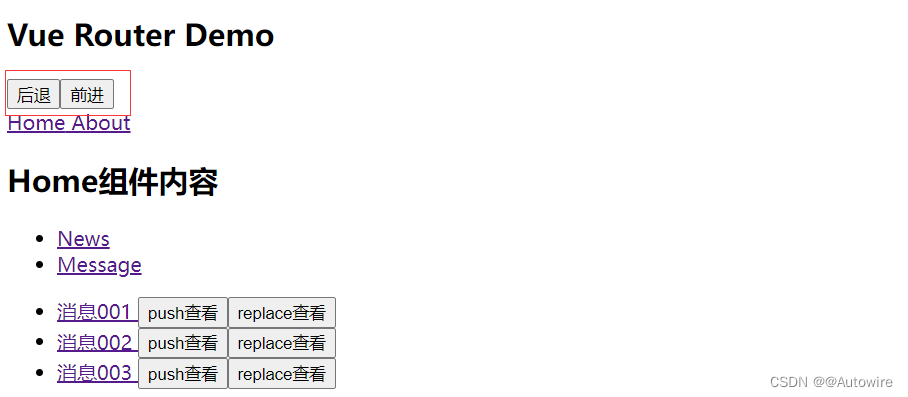
// 前进三步
this.$router.go(3)
// 后退三步
this.$router.go(-3)
11 缓存路由组件
缓存路由组件作用:让不展示的路由组件保持挂载,不被销毁。
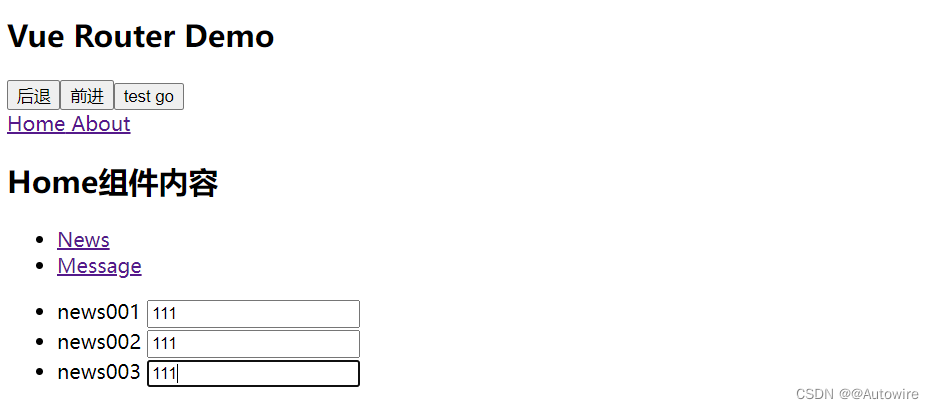
切走之后,被销魂了!!!
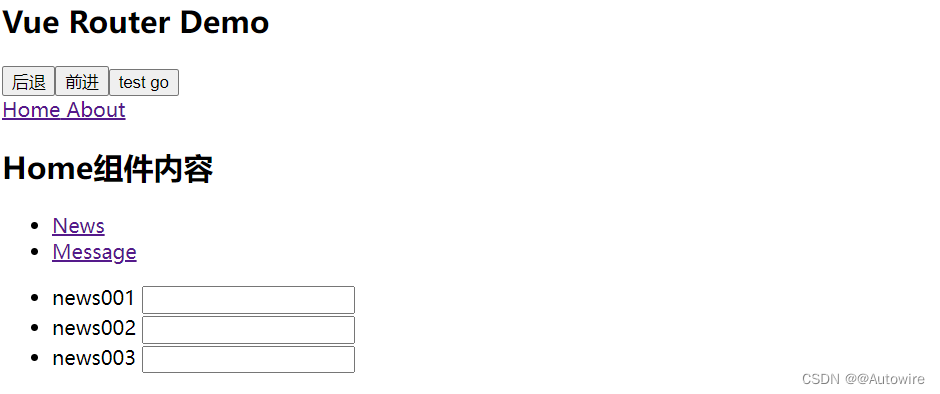
<template>
<div>
<h2>Home组件内容</h2>
<div>
<ul>
<li>
<router-link to="/home/news">News</router-link>
</li>
<li>
<router-link to="/home/message">Message</router-link>
</li>
</ul>
<keep-alive include="News">
<router-view></router-view>
</keep-alive>
</div>
</div>
</template>
<script>
export default {
name: `Home`
}
</script>
<style>
</style>
<!-- 缓存多个路由组件 -->
<keep-alive :include="['News','Message']">
<router-view></router-view>
</keep-alive>
<!-- 缓存一个路由组件 -->
<keep-alive include="News">
<router-view></router-view>
</keep-alive>
12 两个新的生命周期钩子
<template>
<ul>
<li :style="{opacity}">欢迎学习</li>
<li>news001 <input type="text"/></li>
<li>news002 <input type="text"/></li>
<li>news003 <input type="text"/></li>
</ul>
</template>
<script>
export default {
name: `News`,
data() {
return {
opacity: 1
}
},
mounted() {
setInterval(() => {
console.log('@')
this.opacity -= 0.01
if (this.opacity <= 0) {
this.opacity = 1
}
}, 16)
}
}
</script>
<style>
</style>

解决方案:
<template>
<ul>
<li :style="{opacity}">欢迎学习</li>
<li>news001 <input type="text"/></li>
<li>news002 <input type="text"/></li>
<li>news003 <input type="text"/></li>
</ul>
</template>
<script>
export default {
name: `News`,
data() {
return {
opacity: 1
}
},
activated() {
this.timer = setInterval(() => {
console.log('@')
this.opacity -= 0.01
if (this.opacity <= 0) {
this.opacity = 1
}
}, 16)
},
deactivated() {
clearInterval(this.timer)
}
}
</script>
<style>
</style>
两个新的生命周期钩子
1)作用:路由组件所独有的两个钩子,用于捕获路由组件的激活状态。
2)具体名字:
activated 路由组件被激活时触发。
deactivated 路由组件失活时触发。
$nextTick 真实DOM出来之后再回调
13 全局前置_路由守卫
// 该文件专门用于创建整个应用的路由器
import VueRouter from "vue-router";
// 引入组件
import About from "@/pages/About";
import Home from "@/pages/Home";
import News from "@/pages/News";
import Message from "@/pages/Message";
import Detail from "@/pages/Detail";
// 创建一个路由器
const router = new VueRouter({
routes: [
{
name: 'guanyu',
path: '/about',
component: About,
},
{
name: 'zhuye',
path: '/home',
component: Home,
// 二级路由
children: [
{
name: 'xinwen',
path: 'news',
component: News
},
{
name: 'xiaoxi',
path: 'message',
component: Message,
children: [
{
name: 'xiangqing',
path: 'detail',
component: Detail,
props($route) {
return {
id: $route.query.id,
title: $route.query.title
}
}
}
]
},
]
},
]
})
// 全局前置路由守卫 - 初始化时执行、每次路由切换前被调用
router.beforeEach((to, from, next) => {
console.log(to, from, next)
if (to.path === '/home' || to.path === '/about') {
if (localStorage.getItem("school") === 'PekingUniversity1') {
next()
}
}
})
export default router
14 全局后置_路由守卫
$route中的meta:路由元信息
// 该文件专门用于创建整个应用的路由器
import VueRouter from "vue-router";
// 引入组件
import About from "@/pages/About";
import Home from "@/pages/Home";
import News from "@/pages/News";
import Message from "@/pages/Message";
import Detail from "@/pages/Detail";
// 创建一个路由器
const router = new VueRouter({
routes: [
{
name: 'guanyu',
path: '/about',
component: About,
},
{
name: 'zhuye',
path: '/home',
component: Home,
// 二级路由
children: [
{
name: 'xinwen',
path: 'news',
component: News,
meta: {isNext: true}
},
{
name: 'xiaoxi',
path: 'message',
component: Message,
meta: {isNext: true},
children: [
{
name: 'xiangqing',
path: 'detail',
component: Detail,
props($route) {
return {
id: $route.query.id,
title: $route.query.title
}
}
}
]
},
]
},
]
})
// 全局前置路由守卫 - 初始化时执行、每次路由切换前被调用
// router.beforeEach((to, from, next) => {
// console.log(to, from, next)
// if (to.path === '/home' || to.path === '/about') {
// if (localStorage.getItem("school") === 'PekingUniversity1') {
// next()
// }
// }
// })
router.beforeEach((to, from, next) => {
if (!to.meta.isNext) {
next()
}
})
export default router
title的展示:
// 该文件专门用于创建整个应用的路由器
import VueRouter from "vue-router";
// 引入组件
import About from "@/pages/About";
import Home from "@/pages/Home";
import News from "@/pages/News";
import Message from "@/pages/Message";
import Detail from "@/pages/Detail";
// 创建一个路由器
const router = new VueRouter({
routes: [
{
name: 'guanyu',
path: '/about',
component: About,
meta: {title: '关于'}
},
{
name: 'zhuye',
path: '/home',
component: Home,
meta: {title: '主页'},
// 二级路由
children: [
{
name: 'xinwen',
path: 'news',
component: News,
meta: {isNext: true, title: '新闻'}
},
{
name: 'xiaoxi',
path: 'message',
component: Message,
meta: {isNext: true, title: '消息'},
children: [
{
name: 'xiangqing',
path: 'detail',
component: Detail,
meta: {title: '详情'},
props($route) {
return {
id: $route.query.id,
title: $route.query.title
}
}
}
]
},
]
},
]
})
// 全局前置路由守卫 - 初始化时执行、每次路由切换前被调用
// router.beforeEach((to, from, next) => {
// console.log(to, from, next)
// if (to.path === '/home' || to.path === '/about') {
// if (localStorage.getItem("school") === 'PekingUniversity1') {
// next()
// }
// }
// })
router.beforeEach((to, from, next) => {
if (!to.meta.isNext) {
next()
}
})
// 全局后置路由守卫 - 初始化的时候被调用、每次路由切换之后被调用
router.afterEach((to, from) => {
document.title = to.meta.title || '首页'
})
export default router
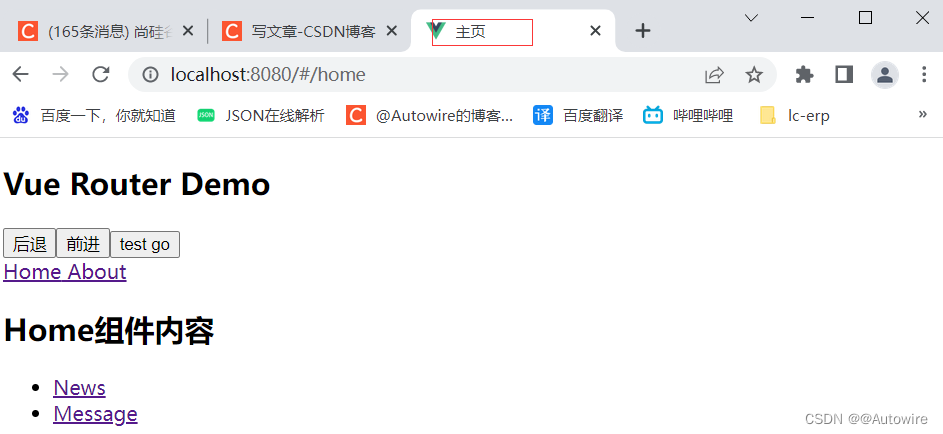
15 独享路由守卫
// 该文件专门用于创建整个应用的路由器
import VueRouter from "vue-router";
// 引入组件
import About from "@/pages/About";
import Home from "@/pages/Home";
import News from "@/pages/News";
import Message from "@/pages/Message";
import Detail from "@/pages/Detail";
// 创建一个路由器
const router = new VueRouter({
routes: [
{
name: 'guanyu',
path: '/about',
component: About,
meta: {title: '关于'}
},
{
name: 'zhuye',
path: '/home',
component: Home,
meta: {title: '主页'},
// 二级路由
children: [
{
name: 'xinwen',
path: 'news',
component: News,
meta: {isNext: true, title: '新闻'},
beforeEnter: (to, from, next) => {
if (to.meta.isNext) { //判断当前路由是否需要进行权限控制
if (localStorage.getItem('school') === 'PekingUniversity') {
next()
} else {
alert('学校名不对,没有查看权限!')
}
} else {
next()
}
}
},
{
name: 'xiaoxi',
path: 'message',
component: Message,
meta: {isNext: true, title: '消息'},
children: [
{
name: 'xiangqing',
path: 'detail',
component: Detail,
meta: {title: '详情'},
props($route) {
return {
id: $route.query.id,
title: $route.query.title
}
}
}
]
},
]
},
]
})
export default router
16 组件内路由守卫
<template>
<div>
<h2>i am about</h2>
</div>
</template>
<script>
export default {
name: `About`,
// 进入守卫:通过路由规则,进入该组件时被调用
beforeRouteEnter(to, from, next) {
},
// 离开守卫:通过路由规则,离开该组件时被调用
beforeRouteLeave(to, from, next) {
}
}
</script>
<style>
</style>

